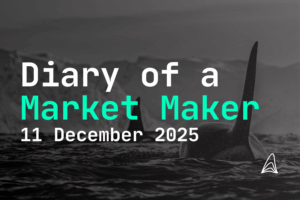
Demystifying Blockchain Layers: A Comprehensive Exploration
- Jakob Brezigar
- Last updated: 12.February 2024
- Reading time: 8 min
When it comes to blockchain technology, understanding the layers at play is crucial for grasping its full potential. This article lays out the hierarchy of blockchain layers, explaining how they work together to secure data and streamline blockchain functionality. You’ll discover the significance of each layer from the underlying infrastructure to the user-centric applications that define the future of digital transactions.

Table of Contents
What is layer 1 layer 2 and layer 3 blockchain?
Layer 1 is the base layer of a blockchain network, allowing layer 2 blockchains to build on top of it, while layer 3 is focused on hosting decentralized applications (DApps). This creates a seamless functioning blockchain ecosystem.
What are the 4 major components of blockchain?
The 4 major components of blockchain are a distributed ledger, a peer-to-peer network (P2P), a consensus mechanism, and cryptography. These elements form the foundation of a blockchain network.
What are the 4 types of blockchain?
The four types of blockchain are public, private, permissioned, and consortium, each with their own advantages and ideal uses. Hybrid blockchains also exist, combining elements of these types for specific purposes.
What is L1 and L2 layer blockchain?
Layer 1 blockchain is responsible for on-chain transactions, while Layer 2 blockchain offloads traffic and handles off-chain transactions to optimize performance.
How does the hardware infrastructure layer contribute to blockchain networks?
The hardware infrastructure layer contributes to blockchain networks by providing the necessary tools and computing power to support network infrastructure, mining cryptocurrencies, and ensuring secure data storage and processing.
Key Takeaways
- Blockchain technology comprises multiple interrelated layers that are critical for the network’s security, scalability, and efficient operation. These layers include the Hardware/Infrastructure Layer, Data Layer, Network Layer, Consensus Layer, Application Layer, and Layer 0, each performing distinct roles and functions.
- Enhancements across different blockchain layers, such as in Layer 1 and Layer 2 solutions, aim to solve scalability challenges by optimizing the base protocol and utilizing off-chain mechanisms to improve transaction processing efficiency and speed.
- Interoperability remains a key component in the evolution of blockchain technology, with initiatives like Cosmos and Polkadot facilitating communication and data transfer between diverse blockchain platforms, while future advancements focus on scalability, security, and decentralization to resolve the blockchain trilemma.
Which Blockchain Layers are most Important for Crypto Market Makers like Orcabay
In the rapidly evolving world of cryptocurrency, market makers like Orcabay play a pivotal role in ensuring liquidity and stability. At Orcabay, we primarily focus on leveraging two crucial layers of blockchain technology: the protocol layer and the application layer.
The protocol layer forms the backbone of our operations, enabling us to build secure and efficient trading algorithms that are crucial for executing large volumes of transactions with minimal slippage. This layer’s robustness ensures the integrity and reliability of our trades. On the other hand, the application layer allows us to interface seamlessly with various cryptocurrencies and assets, providing our clients with a wide range of trading options and enhancing user experience.
The synergy between these layers has been instrumental in Orcabay’s ability to offer competitive spreads and maintain liquidity, even in volatile market conditions. A real benefit that emerged from this approach was our ability to mitigate the impact of a major market dip, by rapidly adjusting our algorithms to maintain stability, ultimately protecting our clients’ investments and fostering trust in our performance. This case study underscores the importance of the protocol and application layers for crypto market makers, demonstrating how they can be leveraged to achieve operational excellence and resilience in the face of market challenges.
Unveiling the Strata: Understanding Blockchain Layers
Blockchain technology, an ingenious invention that has swept across industries, is built on a layered structure. Understanding these layers is key since they underpin the robustness and security of the blockchain network, foster modular and scalable frameworks, and facilitate effective design and interactions with blockchain systems, including transaction data management. The layers within blockchain technology engage with one another to facilitate the operation of the blockchain system, integrating diverse functions, and assuring secure transactions.
The architecture of blockchain encompasses several layers:
Application Layer: Enables end-users to interact with the blockchain network.
Protocol (Consensus) Layer: Assures the legitimacy of transactions and their addition to the blockchain.
Network Layer: Facilitates communication and synchronization among nodes.
Data Layer: Maintains the integrity and security of transactional records.
Hardware/Infrastructure Layer: Provides the necessary tools and computing power.
Each layer plays a unique role in the layers of blockchain, with the Hardware/Infrastructure Layer forming the base and the Application Layer enabling end-user interaction with the blockchain network.
A multi-layered architecture contributes to the network security, efficiency, and scalability in the blockchain by providing:
Credibility assurance
Network authentication mechanism
Modular design for easier maintenance and testing
Improved performance
Introduction of additional functionalities like improved privacy
The Bedrock of Blockchain: The Hardware Infrastructure Layer
The Hardware Infrastructure Layer, fundamental to blockchain networks, is responsible for providing the necessary tools and computing power for effective blockchain functionality. This includes supporting network infrastructure, mining cryptocurrencies, and ensuring secure data storage and processing. The hardware layer is essential for establishing blockchain networks.

Within this layer, the peer-to-peer network architecture plays a pivotal role. It enables decentralized connectivity and resource distribution among numerous nodes, thereby enabling direct transactions between participants without the need for a central server. Data servers, for instance, support the underlying blockchain infrastructure by storing and replicating data across multiple locations to ensure security, reliability, redundancy, and resilience.
Additionally, cryptographic methods are employed to facilitate secure data distribution.
The Keystone: Data Layer Dynamics
The Data Layer, a key component of the blockchain architecture, relates to the base layer blockchain’s data structure, represented as a linked list of blocks that sequence transactions. It encompasses two essential components: pointers and a linked list. The linked list consists of interconnected blocks, each containing data and pointers to the previous block. This structure allows for efficient traversal and manipulation of the data.
This blockchain layer plays a pivotal role in upholding the integrity of transactional records. Once a transaction is recorded on the blockchain, it becomes virtually immutable, meaning it cannot be modified or deleted without leaving a trace. This approach ensures the integrity of the data and makes it resistant to tampering or unauthorized changes.
In addition, hashed blocks within the data layer are responsible for storing the hash of the previous block and the root hash of the Merkle tree. To bolster the security of the data layer further, digital signatures are employed, providing additional protection to the documents and validating the genuineness of the messages and documents.
The Nexus: Network Layer Functions
The Network Layer, often referred to as the propagation layer, forms an integral part of the blockchain architecture. It is responsible for facilitating communication, synchronization, and propagation among nodes to maintain the integrity and consistency of the blockchain. It facilitates inter-node communication within the blockchain network, thereby playing a crucial role in the whole blockchain ecosystem.
A noteworthy concept within the decentralized P2P network is block propagation. This refers to the transmission process of new blocks from one node to another until it reaches all nodes in the network. This peer-to-peer communication is of significant importance for the network’s performance and security.
The network layer encompasses:
The physical network of computers and nodes that communicate with each other
The establishment of the blockchain network
Efficient discovery and interaction among nodes in the network
Consensus Core: The Heart of Blockchain Agreement

The Consensus Layer, central to the blockchain agreement, has the responsibility of:
ensuring that all participants in the network agree on the legitimacy of transactions
determining the order in which transactions are added to the blockchain
upholding the integrity and security of the blockchain
ascertaining the sequence of events in the blockchain
achieving consensus on the chronological order of these events
This layer plays a crucial role in the blockchain’s deterministic nature.
The consensus layer in a blockchain network:
Employs a consensus mechanism to ensure agreement among network participants
Is crucial for building agreement among a network of mutually distrusting participants in a distributed peer-to-peer system
Plays a crucial role in bolstering the security of a blockchain network by validating and reaching consensus on transactions, thereby ensuring their integrity and reliability
Utilizes primary consensus algorithms such as Delegated Proof of Stake (DPoS) and a variety of other algorithms that facilitate peers in reaching a mutual agreement regarding the network’s state.
Application Ascent: From Base Layer to User Interfaces
The Application Layer, the pinnacle of our exploration of blockchain layers, serves as the interface for end users to interact with the blockchain network. A transaction is validated and executed at the semantic layer within the blockchain application layer. Security measures encompass ensuring appropriate authentication and authorization prior to the execution of the transaction.
Blockchain APIs serve as software interfaces that enable developers to engage with a bitcoin blockchain network for constructing decentralized applications (DApps). These interfaces facilitate the amalgamation of various applications and services, thus easing user interaction within the domain of Web3 and blockchain technology.
The Blockchain application layer facilitates the creation of a wide variety of applications, including:
Healthcare
Media
NFT marketplaces
Finance
Banking
Voting
Identity management
Public service delivery
Supply chain management
Layer 0
Layer 0, the fundamental stage, provides the infrastructure protocols for building Layer 1 blockchains. It is instrumental in enabling the functionality of various networks and bolstering the overall structure of a blockchain network. This layer comprises fundamental elements, including hardware components and protocols that are crucial for the physical infrastructure of blockchain networks.

Layer 0 contributes to the stability and efficiency of blockchain networks through the implementation of innovative network infrastructure approaches, such as sharding, parallel processing, and various consensus algorithms. These advancements facilitate efficient and direct cross-chain transactions between different blockchain networks, thereby setting the stage for true interoperability.
Scaling the Summit: Layer 1 and Layer 2 Solutions
As we ascend the blockchain summit, we encounter Layer 1 and Layer 2 solutions, also known as the base layer blockchain. These layers are crucial in tackling blockchain scalability challenges, consequently enhancing the efficiency and speed of blockchain networks.
Layer 1 solutions focus on optimizing the base protocol, increasing the number of transactions per second, while Layer 2 solutions incorporate off-chain mechanisms that enable more efficient transaction processing.
Layer 1 Enhancements: Consensus Protocol Improvements
Layer 1 enhancements focus on updating the base protocol, which involves updates to the consensus mechanism to increase the number of transactions per second, thereby optimizing for speed and scalability. The size of a block directly affects the transaction capacity and overall throughput in a blockchain’s Layer 1 by determining the maximum number of transactions that can be included in a block. Expanding the block size in Layer 1 enables the processing of more transactions simultaneously, leading to quicker transaction clearance.
Sharding, a method that enhances scalability and transaction speed, partitions the network into smaller segments, called shards. Each shard operates with its own set of nodes and handles a segment of the network’s transactions, facilitating concurrent processing. This segmentation contributes to a notable enhancement in the overall capacity of the blockchain network, thereby supporting scalability efforts on Layer 1.
Layer 2 Innovations: Beyond the Genesis Block
Layer 2 innovations operate off-chain, enabling faster and more efficient transaction processing. They incorporate scaling solutions such as:
Bundling transactions
Processing in parallel
Handling transactions off-chain
Off-chain networks or systems constructed on top of a blockchain to expand its capabilities
Rollups, for instance, significantly enhance the speed of transactions and process them more efficiently off-chain, increasing the overall efficiency of blockchain transactions.
Sidechains, separate blockchains interconnected with the main blockchain, offer an additional framework on top of Layer 1 blockchains and enable higher transaction processing capacity. State channels facilitate off-chain transactions between two parties, with the final state being settled on-chain. This effectively decreases the volume of on-chain transactions, leading to reduced congestion and lower fees.
Layer 3
Layer 3 undertakes the task of abstracting various factors, encompassing technologies, functionalities, and features, to accommodate users in a variety of scenarios. It also serves as the foundation for applications that utilize the functionalities offered by Layer 2. Layer 3 simplifies user interfaces and abstracts technical complexities, making blockchain more accessible and user-friendly.
Layer 3 enables the democratization of blockchain by:
Concealing technical complexities
Offering user-friendly interfaces
Providing tailored networks for specific use cases
Primarily dedicated to the development of decentralized applications (DApps)
Provision of infrastructure for decentralized network applications and their associated protocols.
Interoperability Integration: Connecting Diverse Blockchain Platforms
Interoperability, a distinctive characteristic of blockchain technology, fosters the ability of different blockchain networks to interact and exchange information. This attribute enables diverse blockchain platforms to seamlessly integrate with each other. Examples of blockchain platforms with interoperability include sidechains such as Mimblewimble, BTC Relay, POA Network, and RSK. Additionally, initiatives like Polkadot, Cosmos, and Lisk are actively contributing to the advancement of interoperability within the blockchain sphere.
Cosmos, for instance, achieves interoperability between different blockchain ledgers by leveraging its Inter-Blockchain Communication (IBC) protocol, which enables the seamless interaction and transfer of data across diverse blockchain systems within the Cosmos network. Similarly, Polkadot plays a significant role in improving interoperability among blockchain networks through its cross-chain messaging scheme (XCM) and a shared security model, enabling multiple distinct blockchain networks, known as parachains, to communicate and share data seamlessly.
Future Frontiers: Advancing Blockchain Architecture
Looking ahead, the future of blockchain architecture heralds ongoing advancements in scalability, security, and decentralization. Current research and development efforts are focused on reconciling these three pillars of the blockchain trilemma, with endeavors underway to tackle the increasing centralization trend in blockchain technology.

Future advancements in blockchain scalability include enhancements to network infrastructure, the creation of blockchain scaling solutions, and the pursuit of near-instantaneous cryptocurrency transaction speeds. Blockchain security is set to be strengthened through the advancement of sophisticated encryption methods, consensus mechanisms, and smart contract auditing. Furthermore, the incorporation of technologies such as artificial intelligence and the Internet of Things is likely to improve security and dependability.
Lastly, enhancement of blockchain decentralization can be accomplished by:
Transferring control and decision-making from centralized entities to decentralized platforms
Developing additional decentralized network options
Implementing decentralized governance mechanisms
Leveraging improved security and immutability
Eliminating intermediaries.
Summary
In this exploration of blockchain architecture, we’ve unveiled the strata of blockchain layers, from the bedrock of the hardware infrastructure layer to the zenith of the application layer. We’ve delved into the intricacies of each layer, understanding their unique roles and interplay in ensuring network security, efficiency, and scalability. We’ve crossed the bridge of interoperability, realizing the importance of seamless communication between diverse blockchain platforms. We’ve also looked towards the horizon, envisioning the future of blockchain architecture with continual advancements in scalability, security, and decentralization. As the blockchain industry continues to evolve, one thing remains certain: the layered structure of blockchain architecture is the cornerstone of this revolutionary technology.
Disclaimer: The information provided in this article is for informational purposes only and does not constitute financial, investment, or other professional advice. All opinions expressed herein are solely those of the author and do not represent the views or opinions of any entity with which the author may be associated. Investing in financial markets involves risk, including the potential loss of principal. Readers should perform their own research and consult with a licensed financial advisor before making any investment decisions. Past performance is not indicative of future results.

Jakob Brezigar
Jakob, an experienced specialist in the field of cryptocurrency market making, boasts an extensive international presence. With Orcabay, he has skillfully managed major operations and deals for a wide array of global stakeholders.



